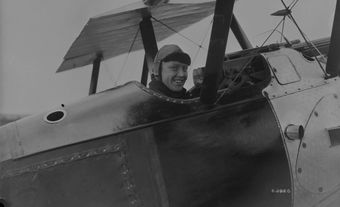Harry Adaskin, OC, violinist, teacher, broadcaster (born 6 October 1901 in Riga, Latvia; died 7 April 1994 in Vancouver, BC). An orchestral and chamber violinist known for his technical facility and warm, sensuous tone, Harry Adaskin formed a duo in 1923 with his future wife, pianist Frances Marr. They toured widely in Canada and abroad, often premiering Canadian compositions in sensitive and perceptive interpretations. From 1928 to 1938, he served as second violin of the Hart House String Quartet. Adaskin established the music program at the University of British Columbia (UBC) in 1946 and taught there until 1973. An excellent raconteur whose musical insights were enriched by his knowledge of painting and literature, he hosted several CBC Radio series beginning in 1938. He was made an Officer of the Order of Canada in 1974.
Early Years and Education
The elder brother of Murray and John Adaskin, Harry Adaskin was an infant when his parents immigrated to Canada and settled in Toronto. He studied with Bertha Drechsler Adamson at the Toronto Conservatory of Music (1913–18, now the Royal Conservatory of Music), with Luigi von Kunits at the Canadian Academy of Music (1918–22), with Leon Sametini in Chicago ( summer of 1922) and with Henri Czaplinski at the Hambourg Conservatory (1922–23). He also took advanced training privately in Paris and Seignelay with Marcel Chailley (summers of 1930, 1931), and attended interpretation classes given by Jacques Thibaud and Georges Enesco in Paris (1931).
Teaching Career
Adaskin began instructing violin students privately in Toronto (1915–22), and then at Upper Canada College (1938–41) and the Toronto Conservatory of Music (1941–46). Among his pupils were his brother Murray, Adolph Koldofsky, Maurice Solway and Harold Sumberg. He moved to Vancouver in 1946 as the first head of UBC's new music department, enlisting the composers Barbara Pentland and Jean Coulthard as teachers. He also instituted a course in music appreciation based on his lifelong interest in music, painting and literature. He retired as department head in 1958 but continued to teach there until 1973.
Performance Career
As a performer, Adaskin began playing violin in Toronto movie theatre orchestras during his childhood and in 1917–18 with Frank Welsman’s Toronto Symphony Orchestra. He was second violin of the Academy String Quartet (1920) and first violin in Milton Blackstone's quartet (1920–22) before serving as second violin in the Hart House String Quartet (1923–38), with which he performed and toured in Canada, the United States, Great Britain and continental Europe.
In 1923, he formed a duo with the pianist Frances Marr, whom he married in 1926. The couple gave the premieres of a number of significant Canadian works: Hector Gratton’s Réminiscence (Toronto 1928, dedicated to the duo); Healey Willan's Sonata No. 1 (Toronto ca. 1930); Patricia Blomfield Holt's Pastorale and Finale (Toronto 1936) and Suite No. 2 (Toronto 1940); John Weinzweig’s Sonata (Toronto 1942); Pentland's Concerto for violin and small orchestra (Toronto 1945, arranged for violin and piano), Vista (Vancouver 1948), and Duo (Vancouver 1960, commissioned by the duo); Coulthard's Two Sonatinas (Toronto 1946) and Poem (Vancouver 1948, dedicated to the duo); Robert Turner's Sonata (Vancouver 1956, commissioned by the duo); and Murray Adaskin's Divertimento No. 1 (Vancouver 1956, dedicated to the duo, premiered with the composer as second violin).
The Adaskins also took Canadian music abroad with them, performing, for example, Gratton's Danses canadiennes No. 1 and 2 and Réminiscence; Willan's Sonata No. 1; Leo Smith’s Tambourin; and Claude Champagne’s Danse villageoise (on the BBC on 22 August 1930). The Adaskins' repertoire also included the standard works, much French music, and a wide selection of 20th-century American and European music, including the Ives Sonatas and the Hindemith Concerto; they introduced the latter to Canada in a violin and piano arrangement. They toured Canada several times between 1944 and 1954, gave New York recitals in 1948 and 1949, and performed often for CBC Radio.
Adaskin's performances were sensitive and revealed intense and perceptive study of the scores. His playing was marked by technical facility and a particularly warm, generous tone. He retired from public performance when he was 69.
Broadcasting Career
Harry Adaskin's "third career" — that of commentator-raconteur-host for CBC Radio — began in 1938 with the lecture series Musically Speaking, which continued with interruptions until 1946. He also was the Canadian intermission commentator for the New York Philharmonic’s Sunday broadcasts (1943–46) and the host for CBC's Tuesday Night series (1970–73). In 1976 and 1977, he hosted the Vancouver Symphony Orchestra’s concert series (live, not broadcast), which also bore the title "Musically Speaking." The 1980 CBC Radio series Fiddler's World featured Adaskin's career, and he narrated three television documentaries on the Group of Seven entitled The Passionate Canadians (1977, 1981).
Honours
Adaskin was appointed an Officer of the Order of Canada in 1974 and received honorary doctorates from Dalhousie University (1978), Simon Fraser University (1979), and UBC (1980). His retirement was spent in Vancouver. His papers and audio tapes were donated to the UBC Archives by his son Gordon. The University of Victoria established the Harry and Frances Marr Adaskin Scholarship in Music History.
A version of this entry originally appeared in the Encyclopedia of Music in Canada.
Writings
"Music and the university," CMJ, vol. 1 (Autumn 1956).
A Fiddler's World: Memoirs to 1938 (Vancouver, 1977).
"Imagination: The Human Gift," Recorder, vol. 20 (March 1978).
A Fiddler's Choice: Memoirs 1938–1980 (Vancouver, 1982).

 Share on Facebook
Share on Facebook Share on X
Share on X Share by Email
Share by Email Share on Google Classroom
Share on Google Classroom


